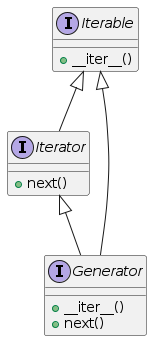from python99.arithmetic.p204 import prime
def test_prime():
assert prime(2,7) == [2, 3, 5, 7]
assert prime(10, 20) == [11, 13, 17, 19]A List of Prime Numbers
by
Problem
Given a range of integers by its lower and upper limit, construct a list of all prime numbers in that range.
Test
Resolution
# A list of prime numbers
# Given a range of integers by its lower and upper limit, construct a list of all prime numbers in that range
from python99.arithmetic.p201 import is_prime
def prime(lower, upper):
return [x for x in prime_generator(lower, upper)]
def prime_generator(lower, upper):
for num in range(lower, upper+1):
if is_prime(num):
yield numIterator
An iterable object is an object that implements iter, which is expected to return an iterator object.
An iterator is an object that implements next, which is expected to return the next element of the iterable object that returned it, and raise a StopIteration exception when no more elements are available.
Generator
Generator functions allow you to declare a function that behaves like an iterator, i.e. it can be used in a for loop.

Yield expressions
The yield expression is used when defining a generator function or an asynchronous generator function and thus can only be used in the body of a function definition. Using a yield expression in a function’s body causes that function to be a generator, and using it in an async def function’s body causes that coroutine function to be an asynchronous generator.
Here it converts function prime_generator to a generator by yield expression. The difference between Generator and List and other Sequence is: elements of generator is created when accessed; but elements of List is created when defined.
Take below code as an example, prime_list returns when found all prime numbers frim range. It found that, it firstly executed all code of prime_list (Check 1, Check 2, …, Check 10), then executed for x in prime_list(1, 10) loop (Iterate 2, Iterate 3, …, Iterate 7).
from python99.arithmetic.p201 import is_prime
def prime_list(lower, upper):
result = []
for num in range(lower, upper+1):
print("Check "+str(num))
if is_prime(num):
print("Found prime "+str(num))
result.append(num)
return result
for x in prime_list(2,10):
print("Iterate "+str(x))Console output:
Check 2 Found prime 2 Check 3 Found prime 3 Check 4 Check 5 Found prime 5 Check 6 Check 7 Found prime 7 Check 8 Check 9 Check 10 Iterate 2 Iterate 3 Iterate 5 Iterate 7
Now check below code, prime_generator return result by yield, it makes primge_genrator as a generator. It found that, prime_generator does not create all elements before for x in prime_generator(2, 10). Instead, create element when access by outer (call next()). For example, when outer accesses first element, it check numbers one by one, return first found prime number.
from python99.arithmetic.p201 import is_prime
def prime_generator(lower, upper):
for num in range(lower, upper+1):
print("Check "+str(num))
if is_prime(num):
print("Found prime "+str(num))
yield num
for x in prime_generator(2,10):
print("Iterate "+str(x))Console output:
Check 2 Found prime 2 Iterate 2 Check 3 Found prime 3 Iterate 3 Check 4 Check 5 Found prime 5 Iterate 5 Check 6 Check 7 Found prime 7 Iterate 7 Check 8 Check 9 Check 10
In case of only requesting one resolution, using generator could eliminate unnecessary effort.